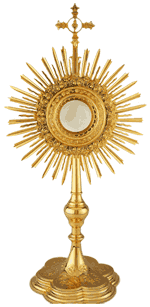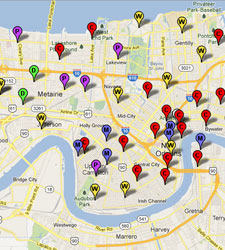Then Jesus took the loaves, gave thanks, and distributed them to those who were reclining, and also as much of the fish as they wanted. When they had had their fill, he said to his disciples, “Gather the fragments left over, so that nothing will be wasted.” So they collected them, and filled twelve wicker baskets with fragments from the five barley loaves that had been more than they could eat. When the people saw the sign he had done, they said, “This is truly the Prophet, the one who is to come into the world.” (Jn 6:11-14) If you regularly attend Mass at the Basilica of St. Stephen, you know that it is rare when I don’t mention the Blessed Sacrament of the Holy Eucharist in a homily. Since Mass is divided into two parts, the Liturgy of the Word and the Liturgy of the Eucharist, I … [Read more...]
Marriage and Sexuality
The desire to love and be loved is the deepest need of our being. We long to be known, accepted, and cherished by another. Yet, the ability to fully give or receive this love is unattainable on our own. As Catholics we believe Jesus Christ has entered our broken world to conquer sin and restore us to new life. Throughout every age he continues to invite all women and men to follow him through his Church, to whom he has entrusted his teaching authority, so that all can know and follow him. Only God can give us the unconditional love and acceptance that we desire. Yet, he has created marriage, a holy union, to mirror this supreme love on earth. At the heart of their married love is the total gift of self that husband and wife freely offer to each other. Because of their sexual … [Read more...]
The Symbolism of the Pelican
During the years I lived in Rome, I spent a lot of time trying to decipher and understand early Christian symbolism. It was a hobby of mine as I visited churches and saw so much iconography. Recently, someone visited St. Stephen Church in New Orleans and asked me about an image that they saw high over the sanctuary of a pelican feeding its young. They wondered why someone would have painted the “state bird” in church! The question gave me a good occasion to reflect upon church symbolism. The image of the mother pelican feeding her baby pelicans is rooted in several ancient Roman legends that precede Christianity. One version is that in time of famine, the mother pelican wounded herself, striking her breast with her beak to feed her young with her blood. Another version was that the … [Read more...]
From the Pastor – July 21, 2024
When he disembarked and saw the vast crowd, his heart was moved with pity for them, for they were like sheep without a shepherd; and he began to teach them many things. (Mk 6:34) Although the image of a shepherd and his sheep is found throughout both the Old and New Testament, many Catholics have a negative reaction to being compared with “sheep.” As I said once in a homily, sheep are stupid, smelly animals who are defined as “classic prey,” in that they are the food of a great deal of predators, most particularly wolves, wildcats and even birds of prey. But once you study a little about sheep, you find analogies to human behavior. For instance, sheep are incredibly social animals. Sheep have a natural tendency to gather into a flock, and they can become very agitated and nervous when … [Read more...]
Good Church Etiquette
An instructive reminder Remember to keep your Eucharistic fast by abstaining from food and beverages (water excluded) for an hour before Mass. Always dress modestly and appropriately. Arrive early to allow for personal prayer and/or read the readings of the day. Turn off all mobile devices while still in the vestibule. This is your time with God and His people. Use the restroom before or after Mass. Men remove hats or caps before the Lord. Deposit all water bottles in the waste receptacles. Make the sign of the cross with Holy Water upon entering. Genuflect with great reverence towards the Blessed Sacrament in the tabernacle before entering your pew. If unable to genuflect, a profound bow is respectful. Refrain from chit-chat which distracts others who are … [Read more...]
Feast of St. Mary Magdalene July 22
Mary was called “Magdalen” because she was either from Magdala near Tiberias (on the west shore of Galilee) or possibly from a Talmudic expression meaning “curly women's hair,” which means an adulteress. In the New Testament Mary is mentioned among the women who accompanied Christ and ministered to Him (Luke 8:2-3), where it is also said that seven devils had been cast out of her (Mark 16:9). She is next named as standing at the foot of the cross (Mark 15:40; Matthew 27:56; John 19:25; Luke 23:49). She saw Christ laid in the tomb, and she was the first recorded witness of the Resurrection. The Greek Fathers, as a whole, distinguish the “sinner” of Luke 7:36-50; Mary, the sister of Martha and Lazarus, and Mary Magdalen. On the other hand most of the Latin Fathers hold that these three … [Read more...]
Willwoods Supper and Substance
Attention Married Couples! You are invited to the ultimate summer date night, the Faith & Marriage Apostolate’s 15th Annual Diocesan-Wide Supper and Substance on Fri., July 26th, from 5:30pm - 8:30pm at Mid City Lanes Rock 'N' Bowl on S. Carrollton Ave in New Orleans! This ultimate summer date night includes a powerful presentation from Jean & Janice Charbonnet, a TOTALLY 80’s dance experience from the band, L’Eighties Night, drinks at the bar, an array of classic Southern Louisiana cuisine to enjoy, and of course bowling throughout the night! To purchase your tickets or for sponsorship opportunities go to FaithandMarriage.org. … [Read more...]
Feast of St. Ignatius Loyola – July 31
Ignacio López de Loyola was born in Spain in 1491, the youngest of 13 children. In 1506, he adopted the last name "de Loyola" in reference of the Basque city of Loyola where he was born. In 1509, Ignatius took up arms under the Duke of Nájera and participated in many battles without injury to himself. However, on May 20, 1521, in a battle against the French, a cannonball wounded both of his legs. During his recuperation at Loyola, Ignatius read the Life of Christ by Ludolph of Saxony, a commentary on the Gospels with extracts from the works of over sixty of the Fathers of the Church; the book influenced his whole life. Ludolph proposes that the reader place himself at the scene of a Gospel story and visualize the scene in a simple contemplation. During his recuperation at Loyola, … [Read more...]
Christmas in July!
A Christmas Giving Tree has been set up next to the St. Anthony Statue. St. Vincent de Paul Society would like to be able to offer more dollars and maybe pay an entire utility bill for someone in need. All donations will be designated to assist with an utility bill payment. Take an “ornament” from the tree in the rear of church and return before the end of July. There is no need to buy a present and wrap it; the Society of St. Vincent de Paul will do the rest! God's blessing to all of you! … [Read more...]
From the Pastor – July 14, 2024
In him we were also chosen, destined in accord with the purpose of the One who accomplishes all things according to the intention of his will, so that we might exist for the praise of his glory, we who first hoped in Christ. (Eph. 1:11-12) The readings for this Sunday are about the idea of “mission.” The word “mission” comes from the Latin verb “mittere,” which means “to send out.” The obvious “sending out” in this week's Gospel is Jesus sending out the Apostles. In fact, the word “apostle” literally means “those sent out” in Greek. The Apostles are sent out on a “mission.” And the idea of “mission” is part of the continuing work of the Church. Every year we have a “mission appeal” in the parish, where we hear about the mission of the church in different countries. However, the idea of … [Read more...]




